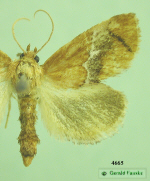Family Limacodidae: Slug caterpillars/ Hag moths
| Diagnosis: Proboscis vestigial; fw trigonate
(triangular), without accessory cell; CuP preserved as a tubular vein in
f/hw; media stem present in discal cell of f/hw.
Diversity: Worldwide two subfamilies, fewer than 1,100 species; North America 50 species in 21 genera; a single species in North Dakota, two others have been found within 30 km. of the eastern boundary. Checklist numbers: 4651- 4700.1. Biology: Larvae, known as slug caterpillars, are slug- like with ventral prolegs modified to sucker disks. Larvae of many species with stinging hairs. Adults have a characteristic resting position with forelegs outstretched and other legs apressed to substrate such that the body is elevated at an acute angle.
|
|
| Further reading:
Epstein, Marc E. 1996. Revision and phylogeny of the Limacodid-group families, with evolutionary studies on slug caterpillars (Lepidoptera: Zygaenoidea). Smithson. Contrib. Zool. 582: 102 pp. Epstein, Marc E. et al., Chapter 10. The Zygaenoidea, pp. 159- 180 in Kristensen, Neils P. ed. 1999. Lepidoptera, moths and butterflies. Part 35, Vol. 1 in Handbook of Zoology. Maximilian Fischer ed. Walter de Gryter, New York. 491 pp. Scoble, Malcom J. 1992. The Lower Ditrysia, Chapter 11, pp. 225- 289 in The Lepidoptera: form, function, and diversity. Oxford Univ. press. 1982. 404 pp. note: most of the North American species are pictured in Holland’s Moth Book– see introduction.
|
|
